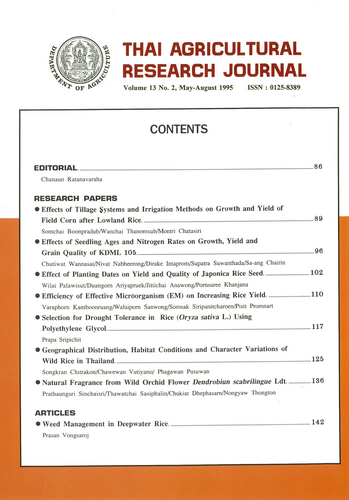Efficiency of Effective Microoraganism (EM) on Increasing Rice Yield
DOI:
https://doi.org/10.14456/thaidoa-agres.1995.11Keywords:
EM, rice yieldAbstract
The efficiency of effective micro-organism (EM) on increasing crop production was reported in many countries i.e. Japan. However, its information on rice yield in Thailand is limited. Therefore, there is a need to find the effect of EM in increasing rice yield and should be used by farmer.rnThe effective of EM on yield of rice was studied on three different soil types of different chemical porperties at three Rice Research Centers : 1) Phrae (PRE); clay loam; pH 5.8 organic matter (OM) 1.12% available P 13 mg2kg (Bray II), and extractable K 6 mg/kg, 2) Prachin Buri (PCR); clay soil, pH 4.12, OM 2.69% , available P 6 mg/kg and extractable K 238 mg/kg, and 3) Phitasanulok (PSL); clay soil, pH 5.03, OM 6.22% available P 20 mg/kg, extractable K 266 mg/kg. The experiment was conducted in cement block filled with the individual soil types. Rice variety RD7 was used in this study. Factorial arrangement of 2x2x2 in RCB with 6 replications was used. The treatments consisted of fumigation soil with methyl bromide and nonfumigation; with and without inorganic fertilizer and with and without application of super EM. Rice was grown to matruity and grain yield was measuredrnThe results indicated that in low OM soils (PRE/PCR) EM did not improve rice yield regardless of treatments. Novertheless, in high OM osil (soil at PSL 6.2% OM) application of EM slightly increased yield. In addition, EM did not decrease gall midge damage in RD7 rice yield.
Downloads
Published
How to Cite
Issue
Section
License

This work is licensed under a Creative Commons Attribution-NonCommercial-NoDerivatives 4.0 International License.
Thai Agricultural Research Journal



